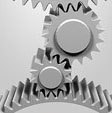| Powder Metal Gears Powder metal gears are formed by compressing metal powders in a die cavity and heating (sintering) the resultant compact to metallurgically bond the powder particles. Secondary operations such as repressing or sizing may be used to obtain precise control of shape and size or to improve mechanical properties. The powder metal process is used to reduce cost by eliminating machining operations, provide accurate dimensional control over large production runs, and obtain characteristics and shapes difficult to obtain by other methods. However, because of molding die costs, high production quantities are usually necessary to realize savings. “As sintered” alloy steels have a tensile strength range of 40-80 ksi (275-550MPa), with an elongation of 4.0 percent or less and an apparent hardness of HRB 60-85. Heat treated powder metal alloys have tensile strengths of 100 to 170 ksi (690-1170MPa)with elongations of 1.0 percent or less, depending on density and alloy selected. Density is the most significant characteristic of powder metal materials. For a given composition, mechanical properties are proportional to density;i.e., higher strengths are achieved at higher density levels. In recent years, powder metal processes have improved to the point where a typical density of 7.0 to 7.4 g/cm# can be achieved using secondary operations. The ductility of powder metal gears is substantially lower than for wrought steels. Hardness specifications can be developed for powder metal gears, but must be specified as “apparent hardness” since the hardness value obtained using a standard tester (either HRB or HRC) is a combination of the powder particle hardness and porosity. The actual hardness of the powder metal material will be higher than the apparent hardness reading and can be more accurately determined using special microhardness measurement techniques. Gears can be heat treated after sintering, but must be processed in a controlled atmosphere to prevent changes in surface chemistry. Carburizing and carbonitriding can be performed, but products with a density under 6.8 g/cm# will not develop a definite case due to the ease of diffusion through the more porous lower density material. Penetration hardness testing cannot be correlated to material strength, but gears will achieve a file hard surface. Salt baths and water quench systems should be avoided. Further improvements in strength can be achieved by the use of hot forming powder metal. Powder metal preforms are heated to forging temperature and finished forged to final shape and density. Gears processed in this manner have strengths and mechanical properties approaching the properties of wrought materials. Although this process is much more costly than the conventional powder metal process, it can still be cost effective for high production gears requiring higher mechanical properties than achievable using the standard process. The controlled porosity in powder metal gears permits their impregnation with oil to provide a self lubricating gear, especially for the internal type of gears. The powder metal process is well-suited to the production of gears for several reasons:
|
|
Remember to bookmark this web site for your future convenience! |
